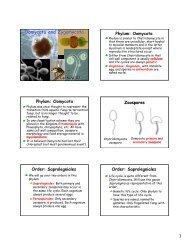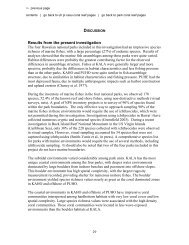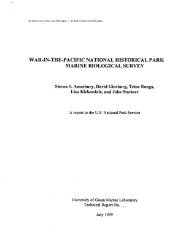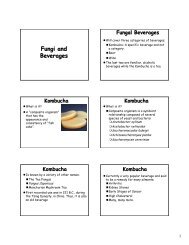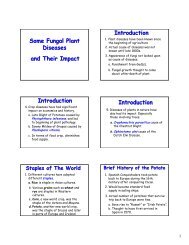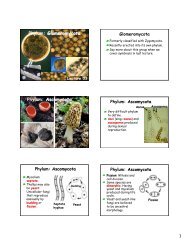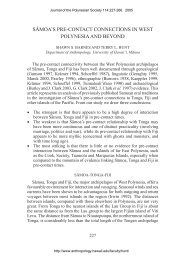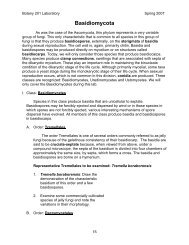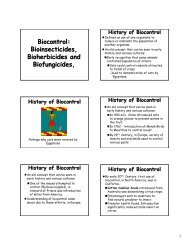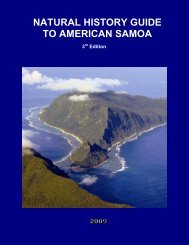american samoa - University of Hawaii at Manoa Botany Department
american samoa - University of Hawaii at Manoa Botany Department
american samoa - University of Hawaii at Manoa Botany Department
- No tags were found...
You also want an ePaper? Increase the reach of your titles
YUMPU automatically turns print PDFs into web optimized ePapers that Google loves.
No stream flow estim<strong>at</strong>es are available for Puna Stream. However, former Aoa resident andprincipal <strong>of</strong> Olomoana Elementary School informed Pedersen Planning Consultants in 1996th<strong>at</strong> Puna Stream flows intermittently. PPC found no evidence <strong>of</strong> stream flow during theNovember 1999 survey.Stormw<strong>at</strong>er Discharges and Rel<strong>at</strong>ed Flood PotentialPedersen Planning Consultants made a hydrologic analysis <strong>of</strong> the potential stormw<strong>at</strong>erdischarges to Aoa wetland during a range <strong>of</strong> storm events.TABLE 4-2POTENTIAL STORMWATER DISCHARGES INTO AOA WETLANDFROM TAPUA AND PUNA STREAMS2,10,50, AND 100-YEAR STORM EVENTSIN CUBIC FEET PER SECOND (CFS)Loc<strong>at</strong>ion 2-Year Storm 10-Year Storm 50-Year Storm 100-Year StormTapua-Lepa StreamDrainage 455 725 1,228 1,392Puna Stream 55 95 180 215All Streams 510 820 1,408 1,607Source: Pedersen Planning Consultants, 2000Through hydrologic modeling, PPC determined th<strong>at</strong> potential stormw<strong>at</strong>er discharges into theAoa wetland can range from 510 cubic feet per second (cfs) for a 2-year storm and about 1,607cfs for a 100-year storm.During PPC’s November 1999 survey, a 17-year resident <strong>of</strong> Aoa informed the survey team th<strong>at</strong>about four homes on the southeast side <strong>of</strong> the wetland are flooded about once a year. Moist soiland w<strong>at</strong>er typically enter this area during the rainy season (Afusia, 1999). PPC represent<strong>at</strong>ivesobserved similar flooding and moist soil conditions during its survey <strong>of</strong> the village in May1996 for the American Samoa W<strong>at</strong>ershed Protection Plan.The potential flood plain associ<strong>at</strong>ed with a 100-year storm event in Aoa was mapped by theFederal Emergency Management Agency (FEMA) in May 1991. Available flood insurancer<strong>at</strong>e maps prepared by FEMA suggest th<strong>at</strong> all inland village areas south <strong>of</strong> the Aoa Bayshoreline have limited flood potential.However, continued landfill in the southeast part <strong>of</strong> the Aoa wetland for residential purposeswill only decrease the capability <strong>of</strong> the wetland to detain stormw<strong>at</strong>er. Future residentialexpansion will likely exacerb<strong>at</strong>e flooding problems and gener<strong>at</strong>e more future property damagesin the southeast part <strong>of</strong> the wetland. PPC represent<strong>at</strong>ives discussed this issue with the villagepulenuu, who is also a m<strong>at</strong>ai, during the November 1999 survey. The m<strong>at</strong>ai/pulenuu indic<strong>at</strong>edth<strong>at</strong> he would discuss the flooding problems and future stormw<strong>at</strong>er detention needs with othermembers <strong>of</strong> the Aoa Village council (Taase, 1999).American Samoa Wetland/Stream Restor<strong>at</strong>ion and Enhancement PlanFebruary 2001, Aoa Wetland, Page 4-4



